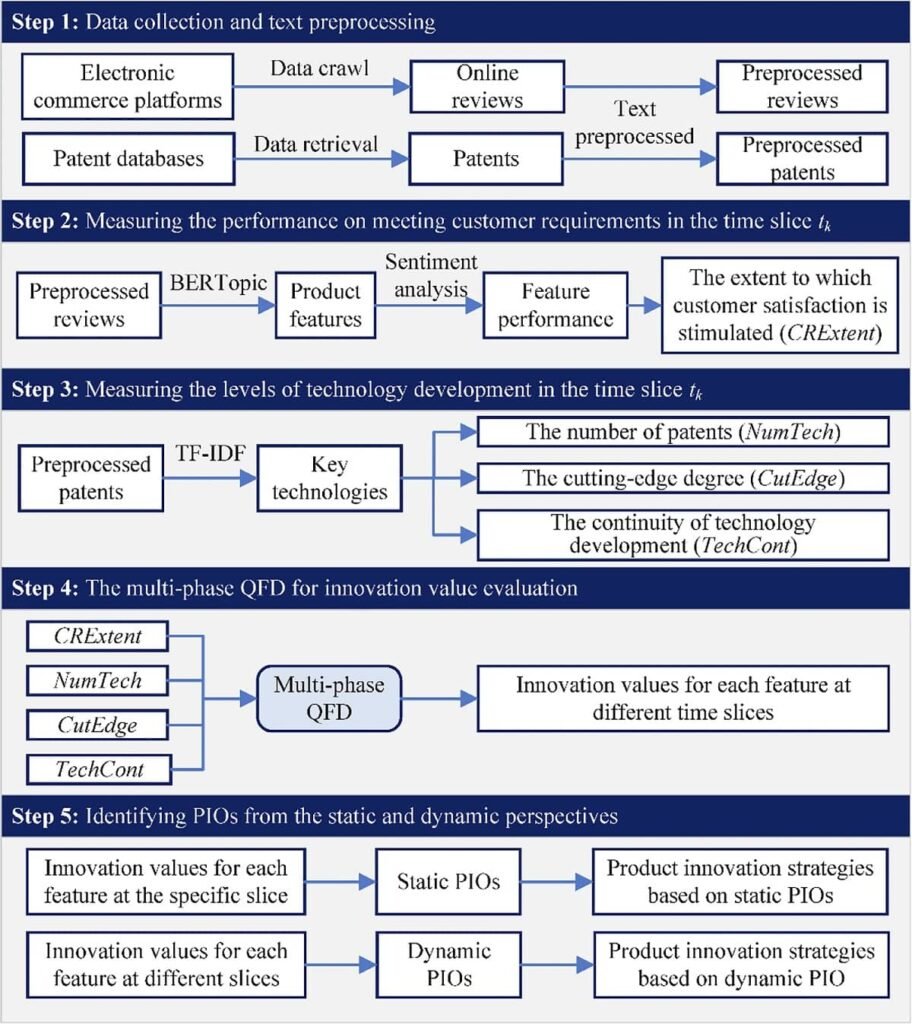
Identifying the next major innovation opportunity is the holy grail for any company. However, many organizations still approach this passively, waiting to see what competitors launch and then imitating it. This reactive approach rarely leads to market leadership; to win, a company must be proactive and systematic.
Traditionally, businesses have looked for these opportunities from two primary sources: listening to customer requirements or analyzing the development of new technologies. The problem is that most studies and methodologies focus on one of these areas, but not both simultaneously. Furthermore, they tend to offer a static snapshot—an analysis of a specific moment that ignores a fundamental truth: needs and technology are in constant evolution.
A recent study in Humanities & Social Sciences Communications proposes a solution to this dual challenge. A research team from Fujian Jiangxia University, Dongbei University of Finance and Economics, and Tianjin University has developed a method for the dynamic identification of Product Innovation Opportunities (PIOs) that integrates both customer and technological perspectives over time. Their approach, based on sociotechnical systems theory, promises to offer companies a more complete and accurate roadmap for innovation.
Key takeaways
- Identifying Product Innovation Opportunities (PIOs) based solely on customer requirements or technological development is insufficient. An integrated approach combining both factors provides a more comprehensive and robust view.
- Customer needs and technology constantly evolve. An effective method must capture these changes over time to reveal how innovation opportunities also shift, enabling both short-term and long-term strategies.
- The systematic analysis of large data volumes, such as online customer reviews and patent databases, is essential for uncovering patterns and trends that are not immediately apparent.
- The Quality Function Deployment (QFD) tool can be adapted into a “multi-phase” model to evaluate innovation value continuously, using performance from previous phases to adjust current results.
- The proposed method not only identifies opportunities but also classifies them by importance (e.g., most important, relatively important), helping companies focus their resources on innovations with the greatest potential for success.
Uniting the two faces of Innovation: Customers and Technology
Sociotechnical systems theory posits that the optimal performance of any system—be it an organization or a product—is achieved only when its social and technical components are jointly optimized. In the context of product innovation, the social subsystem represents the changing requirements and needs of customers, while the technical subsystem encompasses the available tools, processes, and technological capabilities.
Ignoring one of these parts is a recipe for failure. A brilliant technology that doesn’t solve a real customer need will fail to find a market. Conversely, a product that meets a customer’s need but lacks a solid technological foundation can be quickly surpassed. The proposed method seeks precisely that “sweet spot” where customer desirability and technical feasibility meet and evolve together.
How Does This Dynamic Method Work? A Step-by-Step Guide
The researchers designed a five-step process that uses data from online reviews and patent databases to calculate the “innovation value” of product features across different time periods. To validate it, they applied their method to a case study on electric vehicles (EVs), analyzing data from 2019 to 2024.
Step 1: Gathering and Analyzing the Voice of the Customer
The first step is to listen to what customers are saying. Researchers collected thousands of online reviews for different EV models. Using an advanced natural language processing model called BERTopic, they extracted key product features that users care about most, such as “range,” “infotainment system,” or “interior quality.” Then, through sentiment analysis, they measured whether opinions on each feature were positive or negative across different time periods (“time slices”), revealing not only what was important but also how customer satisfaction evolved.
Step 2: Measuring Technological Evolution
In parallel, the team analyzed thousands of EV-related patents to understand the technological landscape. Using text mining techniques, they identified the key technologies associated with each product feature. To assess the development level of each technology, they proposed three innovative criteria:
- Number of Patents (NumTech): How much research is being generated around this technology?
- Cutting-Edge Degree (CutEdge): How recent are the patents? This indicates whether it is a current trend or a mature technology.
- Development Continuity (TechCont): Are patents published consistently or in bursts? A continuous stream suggests a longer and more stable technology life cycle.
Step 3: The Multi-Phase QFD for Evaluating Innovation Value
This is the core of the integration. The researchers developed a dynamic version of the well-known Quality Function Deployment (QFD). Instead of a static matrix, they created a “multi-phase QFD” that calculates the innovation value of each feature in each period, factoring in the results from the previous period. This QFD integrates and weighs data from the two previous steps: the performance in satisfying the customer and the level of technological development.
Discovering Static and Dynamic Opportunities in the EV Market
The results from the electric vehicle case study are revealing.
- Static Opportunities: The analysis showed that the most important opportunities changed in each period. For instance, in the first period (S1), voice interaction (F27) was the highest-value PIO, whereas, in the final period (S5), power (F24) took the top spot. This demonstrates the need to adapt innovation strategies for the short term.
- Dynamic Opportunities: Even more interesting is the long-term analysis. By observing which features repeatedly appeared as important opportunities over the five years, the method identified three dynamic PIOs: car lights (F20), interior (F4), and appearance (F1). Although their innovation values fluctuated, their consistent presence suggests they are reliable areas for long-term innovation investment.
Implications for Innovators: From Reaction to Anticipation
This approach offers a path for companies to shift from being followers to leaders by making more informed and strategic innovation decisions. The implications are clear:
- Evidence-Based Decision-Making: It replaces intuition with rigorous data analysis that balances what customers want with what technology can deliver.
- Agile Innovation Strategies: It allows companies to track changes in PIOs over time, adapting their short-term priorities in response to shifting market needs.
- Short- and Long-Term Vision: By distinguishing between static opportunities (“momentary trends”) and dynamic ones (“underlying trends”), it helps companies balance their innovation portfolio.
In a world where change is the only constant, tools that help us navigate it are invaluable. This multi-phase QFD method does not predict the future, but it offers a data-driven compass to identify where innovation is heading.
Contact
Lin Sun
Dongbei University of Finance and Economics
Dalian, China
Email: sunlin@dufe.edu.cn
Reference (open access)
Zheng, L., Sun, L., He, Z. et al. The identification of dynamic product innovation opportunities using the multi-phase QFD: the customer requirement and technology development perspectives. Humanit Soc Sci Commun 12, 1351 (2025). https://doi.org/10.1057/s41599-025-05629-7
Editor and founder of “Innovar o Morir” (‘Innovate or Die’). Milthon holds a Master’s degree in Science and Innovation Management from the Polytechnic University of Valencia, with postgraduate diplomas in Business Innovation (UPV) and Market-Oriented Innovation Management (UPCH-Universitat Leipzig). He has practical experience in innovation management, having led the Fisheries Innovation Unit of the National Program for Innovation in Fisheries and Aquaculture (PNIPA) and worked as a consultant on open innovation diagnostics and technology watch. He firmly believes in the power of innovation and creativity as drivers of change and development.





